July-August 2004
A Background To Patenting Of Life
By Sean McDonagh SSC
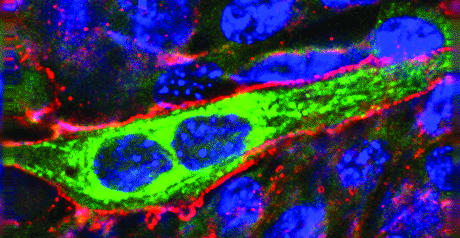
Patents give an exclusive right to an inventor to make or sell an invention for about 20 years. To be patentable an invention must be novel, inventive and serve some useful purpose. Patents have been around since the fifteenth century but until 22 years ago these criteria excluded living organisms. These were always regarded as discoveries of nature, and therefore unpatentable.
In 1980, this all changed. When Ananda Chakrabarty won a US Supreme Court case allowing him to patent a bacterium he had genetically engineered to digest oil, the Chief Justice declared that the ‘relevant distinction is not between animate and inanimate things but whether living products could be seen as human-made inventions.’ This decision heralded a new era in which living organisms could be patented.
Genetic diversity
Genetic diversity is at its richest in tropical countries, which are estimated to contain over 95 percent of the world's genetic resources. In what the corporate world calls 'bioprospecting' - and others call 'biopiracy' - scouts are sent to these areas to seek out valuable organisms or plants, often drawing upon the wisdom of indigenous and local peoples. They then take samples back to the laboratories where they isolate active ingredients or genetic sequences and patent them as their own inventions. Communities can end up having to pay for the right to use something that was previously part of their legacy. The biotech industry argues that this knowledge only becomes valuable once money has been spent on research and commercial products have been developed.
Genetic engineering
Genetic engineering juggles pre-existing components of life. No new gene or genetic material is ever created, just different combinations. By 1985 the US Patent and Trademark Office allowed genetically modified (GM) plants, seeds and plant tissue to be patented. By1988 animal patenting was permitted. Today human gene sequences, cell lines and stem cells are being patented.
The floodgates were opened
The floodgates were opened and by 1990 50 percent of plant patent applications in Europe were coming from just eight transnational corporations (TNCs), among them Du Pont, Monsanto, and Aventis. These companies were pushing the boundaries of patent law even further, staking territorial claims to cover entire species of plants and animals.
The UN Convention on Biological Diversity, ratified by 183 countries and in force since 1993, recognizes the sovereignty of states and communities over their genetic resources. However, the Trade Related Intellectual Property Rights agreement (TRIPS) of the World Trade Organization (WTO) does not.
Since 1995 a key goal of WTO has been to remove barriers to 'free trade.’ Under TRIPS, countries are obliged to bring their patent laws into line with the industrialized nations by extending them to include living organisms or by setting up equivalent systems of intellectual property rights. TRIPS does not require biotechnology companies to ask for prior consent before accessing biological resources, nor does it demand that patent holders share the benefits with the people or lands from which the genes originated. A WTO meeting in November 2001 in Doha said that exclusive rights provided by patents are an important incentive to the development of new drugs. The United Kingdom Government supports the current WTO patent agreement and has so far resisted calls by developing countries to have it reviewed.
Privatising the Commons
There is a similarity between what happened with the Enclosure Acts in Britain in the 18th century, and what is happening today with TRIPS. Canadian Pat Roy Mooney, a veteran campaigner against life patenting, points out: ‘Rich landlords who orchestrated the enclosure movement argued that the commons (land for the use of everyone) must be privatized so that they could take advantage of the new agricultural technologies and feed growing urban populations. In the same way, and with the same arguments, as the Enclosure Acts used to drive rural societies from their ancestral lands (and rights), TNCs are now pursuing another Enclosure Act – the intellectual property ('IP') system. It is privatizing the intellectual commons and monopolizing new technologies based on these commons. ‘What has been happening since the latter part of the 20th century is a new, more invidious form of colonialism. Many of the agribusiness, pharmaceutical and biotech corporations involved in this enterprise have their headquarters in the USA. They can bring enormous pressure to bear on politicians on the national and global stage to design a regulatory regime that promotes their products.
For thousands of years the San bush people of southern Africa's Kalahari desert chewed hoodiacactus stems to keep hunger at bay. The drug company Pfizer now owns the rights to an anti-obesity drug, based on the hoodia, which could be worth millions.
There have been 13 patent applications on the eucalyptus tree, an evergreen mainly native to Australia and with medicinal properties. One applicant has been the chemical company ICI.
’Oncomouse’ was a transgenic mouse and the first mammal to be patented in 1988. A breast-cancer gene was spliced into its makeup to aid cancer research.
Challenging the commodification of life
Life, which was once considered sacred and a gift from God in almost all the religions and cultures of the world, is now perceived by some as human invention – a collection of genes and chemicals that can be engineered, bought and sold by a patent holder. Life will only have value in so far as it generates a profitable return on investment for large companies. Such a reductionist, mechanistic and materialistic concept of life is at variance with the tenets of all the major religions and with the spiritual traditions of tribal peoples. A nineteenth century speech, attributed to the native North American Chief Seattle, bemoaned Western arrogance that thought we could, ‘buy or sell the sky or the warmth of the land.’ For Chief Seattle, every part of the earth is sacred.
The US Supreme Court's view of life also differs radically from the way life is understood, revered and cherished in the Judeo-Christian tradition. The first line of the Bible insists that everything was created by a living God: ‘In the beginning God created the heavens and the earth (Gen 1:1). The text is very clear that all living beings, including human beings, are creatures of God.
The first account of creation goes on to teach that all beings have their own inherent value. This dignity derives from the fact that they are created by God (Gen 1:12, 19-25). In the second account of creation the man is given the privilege of naming the animals
(Gen 2:19-20). The text recognizes that all creatures, including humans, have a common origin. They are created from the soil. God invites the man to care for the animals with a sense of responsibility and good stewardship. While this gives humans dominion over
other creatures, it is not an arrogant dominion with the right to oppress and exploit. Rather, it is supposed to be patterned on God's own care and sovereignty, enhancing God's creation. This is expressed in Psalm 72:4-6 where the righteous king combines concern for the poor and care for the creatures of the earth.
Creation: an all - encompassing activity
In the Judeo-Christian tradition, creation is an all-compassing activity. It is not a once-off action in the distant past by a mechanistic God who immediately abandons the world to its own devices. God is perceived as living in each of His creatures in the here and now. God holds together the web of life and leads all creation into the future (Psalm 104). Our world is evolving and has its own unique processes. The Bible does not share the reductionist myopia of the US Supreme Court that saw life as an isolated entity and as a product of human industry. Patenting is a fundamental attack on an understanding of life as interconnected, mutually dependent and a gift of God given to all creation. ‘Oh, come to the water all who are thirsty; you who have no money, come! Buy corn without money and eat, at no cost, wine and milk.’ (Isaiah 55:1). It opts instead for an atomised, isolated understanding of life. It is also a variance with the Judeo-Christian conviction that freedom, openness and possibility are the hallmarks of life in God's creation.
Limits on the uses of the natural world
The Bible recognizes that humans are companions and stewards of other creations in the community of life (Gen 2:15). In Gen 2:15-17 God settles the man in the garden and invites him to cultivate and care for it. The text goes on to place certain limits on the man's use of the natural world. Yahweh God gives him this admonition: ‘You may eat indeed of all the trees in the garden. Nevertheless, of the tree of knowledge of good and evil you are not to eat, for on the day you eat it you shall surely die’ (Gen 2:16-17).
The Bible is very critical of those who, puffed up with arrogance, refuse to recognize that they are dependent on God. In the story of the Tower of Babel (Gen 11) humans repudiate God's sovereignty and attempt to storm heaven under their own steam. It would not be misrepresenting the meaning of its text to interpret any claim to own life as usurping the Divine prerogative as the author of life.
A Revolutionary From The Heart
FR NIALL O’BRIEN, 1939-2004
By Fr Seán Coyle
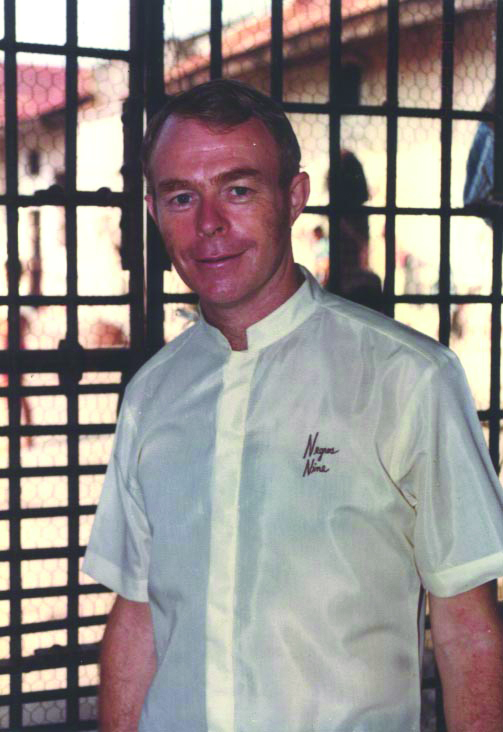
I first met Niall O’Brien on 5 September 1961, the day I entered St Columban’s seminary in Ireland. He was four years ahead of me. Just over a year later the Vatican Council began. It was a time of great excitement in the Church, a time of great change, a time when many shared the hope of Pope John XXIII, who had convened the Council, for a ‘New Pentecost.’ Father Niall was ordained in December 1963, just after the second of the Council’s four sessions and a few months after the death of Pope John.
His Restless Mind
While still a student the young Niall O’Brien was living out something of the spirit ofaggiornamento, ‘updating,’ the Italian word used by many to describe what the Council was about. He was struck too by what Pope John was supposed to have said, ‘We need to open the windows and let some fresh air blow into the Church.’ As a student Niall organized a yearly visit of Malaysians studying medicine in Dublin, Ireland’s capital, to our seminary. Very few of these were Christians. He also organized at least two national gatherings of seminarians, with some from overseas and some Anglicans, at a time when many bishops and others in authority would have grave doubts about this.
However, Niall was a model student in his sense of obedience. In a very quiet way he was a revolutionary but not a rebel. He had great respect for the system he had entered and for those in authority but saw the need for change and that he should be part of that.
New Ways to Preach
This questioning spirit was a characteristic for the rest of his life. It was more than that. He was always looking for new ways to preach the gospel of Jesus Christ. In his early years in southern Negros Occidental, the territory the Columbans took over in 1950 and which became the Diocese of Kabankalan in 1988, he became very much involved in the SaMaria movement, something like the Cursillo, which gave men, most of them economically poor, an intensive experience of faith and instruction in the faith over a period of three days. And this was in the Hiligaynon or Ilonggo language. Part of the vision of the Council was that people should hear the Word of God proclaimed in their own language at celebrations of Mass and the sacraments. Latin, still the official language of the Roman Rite of the Catholic Church, the rite to which the vast majority of Catholics belong, was used in all liturgical celebrations before, the vernacular hardly at all.
Mass in Hiligaynon
Father Niall began to draw up services in Hiligaynon for communities that couldn’t have Sunday Mass. He was invited to be part of the commission set up by the bishops of the Ilonggo-speaking dioceses to translate the Mass and the sacraments into that language. Though he was a foreigner, the bishops and others recognized Father Niall’s competence in the language and his passion for enabling people to worship God in that language. He would never accept the widespread description of Filipino languages, which are remarkably complex and sophisticated, as ‘dialects.’ He was chairman of the commission for some time.
Because of his experience of the hardships of people living on haciendas and of the plight of the sacadas, seasonal workers, he helped set up a kibbutz in the mountains of Tabugon, Kabankalan City, Negros Occidental, in the 1970s. This cooperative was another example of his ability to learn from what was being done elsewhere, in this case modern Israel. The kibbutz is still operating, though he wasn’t directly involved in the running of it in recent years.
Their Arrest
The defining event of his life took place in 1983-84 when he was part of the ‘Negros Nine,’ three priests and six men who were parish workers falsely charged with the murder of Mayor Pablo Sola of Kabankalan and four of his companions. On 5 May 1983 the group were arrested. For eight months the three priests – the others were Australian Columban Fr Brian Gore and Fr Vicente Dangan of the Diocese of Bacolod – were under house arrest, the last part of that being in the Police Constabulary Camp in Bacolod. However, the three priests were not happy being separated from the others and ‘broke out’ of the camp and ‘broke into’ the jail. The late Bishop Antonio Y. Fortich of Bacolod appointed them chaplains there. The priests got lawyer-friends to follow up the cases of many poor prisoners who had been forgotten.
While they’re in Exile
The ‘Negros Nine’ became international figures at this stage and Fathers O’Brien and Gore national heroes in their own countries. It astonished people in Ireland and Australia that the authorities allowed them to be interviewed live on television and radio from their prison cells. After the release of the Nine on 3 July 1984 the two Columbans returned home. While in Ireland Father O’Brien wrote Seeds of Injustice, based on the diary he kept in jail. That was published in Ireland but his second book, Revolution from the Heart, came out in Ireland, the USA and the Philippines where it was launched by Ricardo J. Cardinal Vidal, Archbishop of Cebu. Japanese, Korean, German and Spanish translations also appeared and the book is still selling. I’ve met people who told me they cried through this book, which is a theological reflection of the first twenty years of Father Niall in Negros, culminating in the ‘Negros Nine’ experience.
Island of Tears, Island of Hope, followed in 1993. This too is a theological reflection on the experience of the people of Negros Occidental and focuses on the role of the late Bishop Antonio Y. Fortich who died last year just short of his 90th birthday. Father Niall had a great love for this outstanding bishop.
Misyon Magazine
During his break in Ireland after his time in jail the Columbans in the Philippines came up with the idea of a magazine that would highlight the work of Filipino missionaries overseas and at the same time encourage young Filipinos to become Columban missionaries and the people to support them. The co-founders of the Columbans, Father, later Bishop, Edward Galvin and Father John Blowick, started magazines in Ireland, Australia, the USA, and, for a brief period, in Argentina, immediately after the Society was formally established in 1918. They saw this as the most effective way to raise people’s awareness of the missionary life of the Church and to obtain their support for missionaries. These same magazines were to lead many young men, including Father Niall and myself, to join the Columbans.
When Father Niall returned to the Philippines the then Regional Director in the Philippines, Father Paul Cooney, who died last year, asked him to undertake the launching of the magazine. So Misyon first appeared in September-October 1988 under his editorship. He continued as editor till the end of September 2002 when ill-health made it very difficult for him to continue. He had been working from his room in Ireland, where he had been getting treatment for a rare form of anemia, for about 18 months. The last issue he edited was that of January-February 2003. (We work well in advance of publication date.)
Misyon has been a forum for Filipino missionaries of many congregations and societies as well as for lay missionaries and Filipinos working overseas trying to live the Gospel. Like other Columban magazines, it has inspired a number of young people to become missionaries, as letters, emails and articles we receive, can testify.
Like a thief in the night
When he returned to the Philippines in December 2002 he had the idea of launching a pastoral magazine aimed at priests and parish workers. He had already set up a board, after contacting all the bishops of the country, many priests, parish workers and journalists, and was ready to go ahead when he left for Pisa, Italy, in December, a few weeks before the 40th anniversary of his ordination. He was hoping that a new, experimental treatment would help him recover. Sadly, a few days after a fall while trying to get out of his wheelchair, he died on 28 April.
His Love for Art and Books
Father Niall had a special love for Italy and all things Italian. In recent years he had spent part of his vacations looking after small parishes in that country, bringing his mother with him. He spent hours in art galleries there, as he did in the National Gallery in Dublin. The paintings and sculptures of the Great Masters were for him an expression of the beauty of God.
Another love, which we shared, was for the writings of PG Wodehouse, an English author who created what someone called ‘a world before the Fall,’ a world of sheer escapism and delight among people with no social responsibilities whatever. Wodehouse, who had a wonderful way with words, was described by Irish playwright Seán O’Casey as ‘the performing flea of English literature.’ Not long before he left the Philippines for the last time Father Niall borrowed a collection of stories by PG Wodehouse from me. I told him that he would face the death penalty if he didn’t return the book. He returned it!
But during his time in Bacolod Jail Father Niall had nightmares about the possibility of facing the death penalty, though he was totally innocent. His lifelong opposition to capital punishment was part of his commitment to peace and active non-violence. He helped introduce Pax Christi, an international Catholic peace movement, www.paxchristi.net , to the Philippines in 1995 and served as national chaplain till his death. He was a speaker at a number of international congresses. He found inspiration in the lives of peace activists such as Gandhi and Martin Luther King but for him his work for peace was a demand of the Gospel of Jesus Christ and an expression of his faith.
Since he came back to Bacolod in December 2002 Father Niall often spoke to me of his great admiration for Pope John Paul. They were kindred spirits in many ways, both professional communicators, both men of faith, both men with a strong sense of tradition, and both definitely not rebels, but quiet revolutionaries from the heart.
Door-To-Door – From Hong Kong With Love
Sr Leticia Bartolome ICM

Are you going 'door-to-door?’ A question Filipino migrant worker often asks one another. A positive reply gets a second question: ‘Jumbo, regular, half or bulilit?’ What funny and strange names, I thought. One night, coming home from a meeting with the board and staff of the Asian Migrant Centre here in Hong Kong, I felt exhausted and fell into a deep sleep. It was then that I met Jumbo, Regular, Half and Bulilit in a dream. We talked for a long time.
Meeting the boxes
In my dream I saw them very clearly and their names fitted their personalities. Jumbo was big and fat, Regular just the right size, tall and pleasantly plump; Half was thin and short while Bulilit was an anemic-looking dwarf. There weren’t only four, but hundreds of cartons covering the floor, still waiting for costumers. I looked around and found that I was in the office-cum-warehouse of a company that transported goods. It was so quiet. I was alone with these boxes. Some of them, almost bursting from over-capacity, were ready for transporting, with the names and addresses of their destinations pasted on. Others were partly open, ready to be filled with more goods.
Over packed
‘Ouch! Aray!’ I heard someone moan. ‘Ouch! Aray!’ I followed the source and found a jumbo box tied and almost covered in strong tapes to keep it intact. ‘What’s the matter?’ I asked. ‘I feel so heavy and so full,’ answered Jumbo. ‘We too,’ complained Regular and Half. Bulilit, sighed almost in a whisper, ‘I think I’ll die.’
How could I help them? Perhaps I could divert their attention from their misery and allow them to talk?
You name it
‘What are you carrying inside?’ I asked. All four replied in unison, ‘Everything!’ ‘Everything???’ I asked unbelievingly. ‘Yes, we have school supplies, canned goods, daily supplies for the kitchen, even pots and pans, bars of chocolates and boxes of candies, clothes, shoes, towels, soap, blankets … you name it, we have it. That’s why we’re bigger than we’re supposed to be.’ ‘But why? We have all those things at home in the Philippines!’
Story behind
One by one they explained. One had heard a woman say that she had to make sure that her children would have their school supplies. If she sent money it would be spent on other things. Other families don’t have what they need and so depend on the door-to-door boxes. Another woman had said that her husband spent the money she sent on drinking with his barkada or on dates with another woman. What emotional misery these migrants suffer living away from their families!
Listening to them made me cry. I tried to wipe my tears with a handkerchief but couldn’t find it in my handbag. I woke up and found my pillowcase wet.
‘Door-to-door.’ ‘From Hong Kong with love.’ When a box arrives at its destination, do the recipients realize the big sacrifices that go with it? Do they reciprocate the love that is symbolized by the things sent home? One story going around lately is that of a woman who stopped working because her contract was terminated. When she went home to her family she felt she wasn’t welcome and that she had become a stranger to them. She had no more money. She left and returned to work in Hong Kong but now she knows better. She has started to save money for her own future. No more ‘door-to-door’ for her.
In Him Alone
By Noe Hijara Pedrajas

It was the summer of 1990, fiesta day in our barrio, when my best friend died of leukemia. He was only 27, I was 12. Every time I remember that sad day, I feel like crying, though I try to hide my pain with a smile. He was my best friend, so loving, so dear to me. He seemed to possess everything I could want in a friend. He would hug me whenever I felt alone. He was fun to be with. He would defend me against the taunts of others. He was creative and helped me with my school projects. I remember in sixth grade our class was assigned to make a bamboo vase. Not even my father knew how to make one. I didn’t know what to do. My best friend came to my rescue and helped me fashion it.
Why my brother?
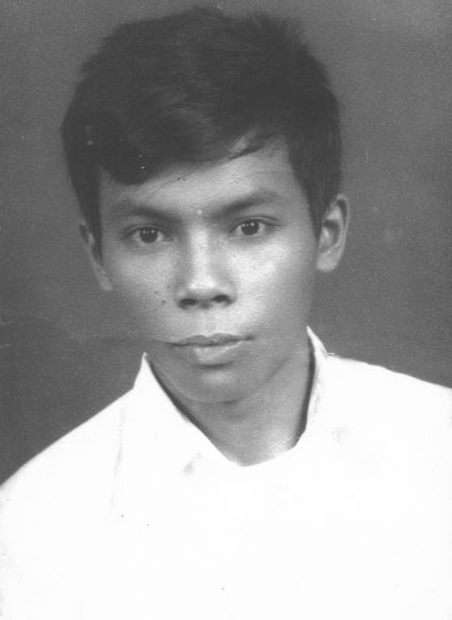
Kuya Totong
It is hard to lose someone so valuable, someone like my dear Kuya Totong. He was the eldest among my siblings. To me he was more than a plain kuya; I considered him my very dear friend. The pain I felt at his death is indescribable. I felt lost; everything seemed dark. That fateful day of 4 April 1990 shattered almost everything in me. My friend, my dear brother, was gone. . . not just for a moment, but forever. It meant that we would no longer enjoy each other's company. It meant that I would no longer feel his reassuring hugs and kisses. It meant that I could no longer turn to him for guidance. I was disconsolate and in my young heart I turned to God with my puzzled question. I asked him, Ngaa utod ko pa gid imo ginkuha haw? Why should you take my brother away? I resented God and accused Him of playing favorites. Why did He take my brother? Why not somebody else? My brother was a good man; he never gave our parents cause for worry or pain. He loved God; he loved life; he had plans, not only for himself but also for us, his six siblings. So, why him, God? It was the age-old question of a person who didn’t understand the ways of God.
My mother’s faith
Days passed into weeks, months and years. I am now a grown man myself, but can still feel the pain I felt that day. If it was hard for me to accept what happened to my brother, all the more so was it for my mother. There was no logic to my brother's early death. But she clung to her faith for consolation. She too, had come to accept that God's ways are not our ways and that life must go on!
Just two years after my brother's death, my father followed him to the grave on 4 December 1992. This second blow to my life rekindled the pain I felt at my brother's death. Again, I questioned God. Again, my mother didn’t understand. Amid all the pain, the loss, the lack of understanding, however, she remained firm in her faith - no questioning, no resentment, no bitterness, just tears of sorrow. Life went on; it had to. My mother bravely faced the task of supporting our family. We fell into hard times. My brothers and sisters had to stop schooling in order to help support our family. We complained, yes, we did, but somehow there was hope in our hearts that someday with God's help, we would be blessed with good fortune.
Seeing beyond the suffering
How true is the saying attributed to St Thérèse of the Child Jesus that everything in life is grace from God. Whatever we experience - failure, disappointment, despair, anxiety, pain of loss, enmity, infamy and disgrace, seemingly never ending struggles, happiness, greatness - all is grace from Him. We can only discern this if we regard them with the heart, with the inner eye of faith.
I strongly believe that with the eyes of faith we can see God behind life's seeming absurdity. Life may indeed seem absurd at times; that is why many times we find ourselves confused and lost. Thus we succumb to our weakness, which is to seek happiness in worldly things, with nary a thought of God at all. We mistake these worldly things as essential, rather than regarding them as they really are, passing, inconsequential things. We believe that they can satisfy our inner hunger, only to find out in the end that they cannot. It is for this reason that we should always cling to God even and especially during moments of trial.
The meaning of pain
Faith, then, sees life's pain as gain. Many times pain comes to us and overwhelms us and we are tempted to surrender, to give up. The sad thing is, we get so involved in our misery that we fail to see God's hands moving in our lives. This situation is confounded when we turn to God and feel a dryness, an absence. It is during times like this that God is nearest to us, closer to us than we are to ourselves. He embraces us with His reassuring love. What then is the meaning of pain? Pain can strengthen our faith, that faith that gives life and light. Faith strengthened by pain is God's way of making us gain, giving us the courage, have full trust and confidence in no one else but Him alone.
The Lord Jesus who is Light Himself assures us that there is light behind the darkness. The grace He gives us is superabundant, if only we wouldn’t lose hope and faith. Faith in Jesus urges us on, despite our frailties, to accept His will, even if it means losing everything, even those we love - a brother, a best friend, a father. Faith in Jesus urges us to burn our bridges behind us and walk with hope in the now and toward the future.
Our Hideaway
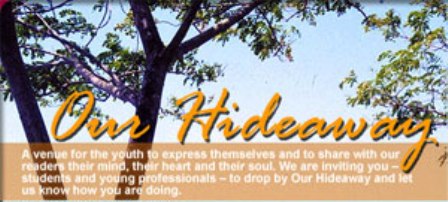
A Step Forward
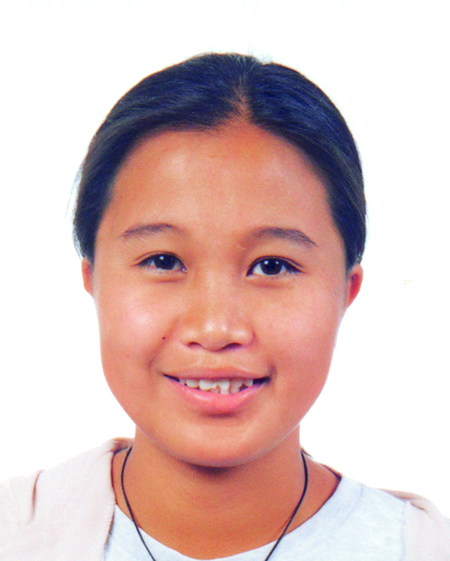
By Apryl Gretchen Cofin
When I was young, my mom brought me to Mass every Sunday, though I didn’t know what was going on. During my elementary days, I sometimes felt forced by her to go. Because Mom was a catechist I felt very ashamed if we, her own family, didn’t attend any church activities. Maybe that’s why I went every Sunday without conviction and didn’t pray sincerely.
Because I saw myself as a devout Catholic, I sometimes became very defensive when members of other sects criticized my religion. I couldn’t run away from my hurt and anger if they continued criticizing. Though I sometimes ignored the existence of God and often went to church just to be present and pass the time, I didn’t like my religion to be attacked. I admit that sometimes I was a hypocrite, cheating myself and the Lord. My attitude didn’t improve when I reached high school.
My First Downfall
Entering high school was really terrible and was my downfall. I lost the opportunity to be a good student. It began in first year when I wasn’t included on the honor roll. This really shocked my family and me. My elementary teachers were also surprised and asked me about it but I preferred to remain silent. Maybe they didn’t see my hurt, but deep inside I was really crying. I was like a bomb ready to explode. I attended Recognition Day but left during the announcements. It was really painful, all my hopes and dreams of achievements in high school vanished.
I joined Youth for Christ (YFC) but that didn’t work. I got even worse. Losing a medal became a tragic moment in my life, but I didn’t accept defeat. That’s why I became a pessimist and preferred to stay in a dark corner and hide my dark shadows. I was afraid the things I was hiding would be revealed and that others would reject me.
Painful Past
During the following years, I didn’t concentrate on my studies because I stuck to my belief that I’d no longer be an honor student. What was the use of studying hard? I’d been disappointed once and didn’t want the same thing to happen again. I kept blaming others, not realizing that I should blame myself also. Studying always reminded me of what happened in first year. The pain kept coming back, each time a fresh wound, no matter how much I tried to forget everything. I had a really poor self-image, always looking on the dark side of life. My friends commented on my wrongdoings but I did what I thought was right for me.
Feeling of Emptiness
I was always making foolishness in school and happy doing it. One time I threw a big stone onto the roof of the sophomores’ building. I was called to the faculty room and badly scolded. After all of this, though ‘happy’ with my foolishness, I felt empty inside. I was searching for something that would satisfy my hungry and thirsty self. I attended some church activities but there was still no change because I didn’t really want to hear the word of God. Sometimes I heard comments from my classmates, ‘Hey, Gretch, you’re going to church but you never change.’ I felt very ashamed but just ignored them.
I’m now in fourth year, still struggling with my poor self-image, taking my studies for granted because what happened before keeps flashing back. I’m finding it hard to leave my dark corner.
Time to Change
I’m really tired of pretending. I want to change but don’t know what first step to take. During our Youth Encounter in January, I really talked to the Lord for the first time and really cried. Before, I prayed only when I needed something and saw prayer as boring and a crazy thing to do. But today I want a new atmosphere and a new world for myself. I’m already beginning to cope with my mistakes in life. I want to leave the past that brought me so much agony and live a better life today. I know that today is more important than yesterday or tomorrow. I need time for myself to know who I really am. I can’t turn back time so I need to look forward.
And I need your prayers for me to change totally.
Service In Love Through The Years
By Sister Mary Florence del Mundo SSpS
A tiny seed planted as a dispensary in a suburb of Mumbai (Bombay), India, in 1966, became Holy Spirit Hospital in 1967 with 65 beds. It was then popularly known as ‘The Jungle Hospital’ since it was surrounded by heavy jungle. Today that tiny seed has grown and spread its branches, standing proudly as a modern, well-organized and full-fledged 280-bed general hospital, catering to the comprehensive health care of around two million people.

Upgraded
We are indebted to our pioneer Sisters, especially Sr Carmel Ann and Sr Willibrord and others who through their hard work and generous spirit helped the hospital become what it is today, offering a wide variety of services, ranging from basic medicine and general surgery to specialties such as neurosurgery, plastic surgery, pediatric surgery, urology and nephrology, among others.
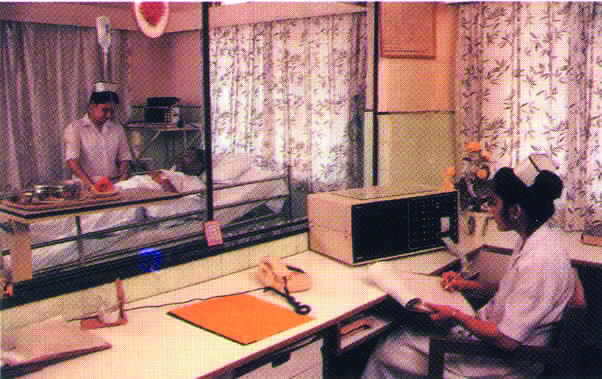
Cardiology, ICU
Holy Spirit Hospital regularly upgrades its facilities that now include a modern 26-bed intensive care unit of international standard, realizing one of the felt needs of the people around. Our kidney unit reaches out to many with chronic renal failure, having on average 600 dialyses per month. We collaborate with various trust funds that enable us to serve poor patients.
Outreach Clinics
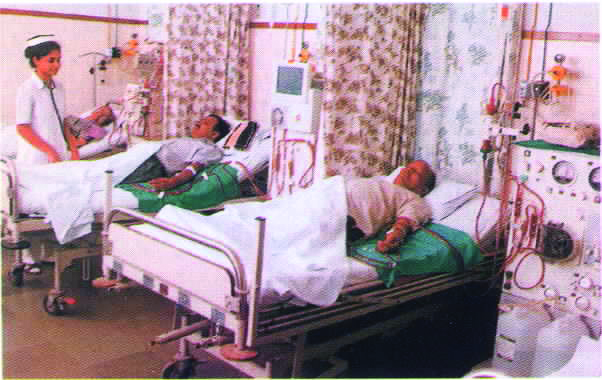
Dialysis
Holy Spirit Hospital has four outreach clinics or community health centers in the slums near the hospital. We have a team of doctors, nurses, social workers and paramedics who work daily in these centers providing both curative and preventive care. The hospital serves as a referral center for the clinics and tries to make health care available at an affordable cost to the poor who live in the area. Ten percent of our patients are slum dwellers who get free treatment; 70 percent belong to the low-income sector and receive concessions. Only 20 percent are fully-paying patients. Our reach-out includes prenatal care, family visits, health education in schools and for women. We also have AIDS awareness programs. A member of parliament gave us a mobile hospital, a great boost to us.
Moving Onwards
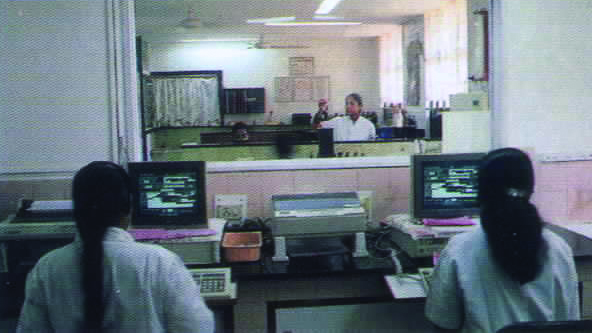
The hospital began an institute for nursing education in 1997, where young women are trained with our organization ethos, to provide person-oriented quality care for patients. However, India’s laws require that we upgrade the institute into a college of nursing within a few years.
All medical, paramedical, and supportive services are well integrated to provide a holistic approach to healing. Our pastoral care department provides spiritual assistance and counseling, helping patients and families to cope with the trauma of illness. We have 100 medical and 500 non-medical staff. In 2002, for example, they took care of around 11,000 inpatients and nearly 98,000 outpatients.
Unbounded Service
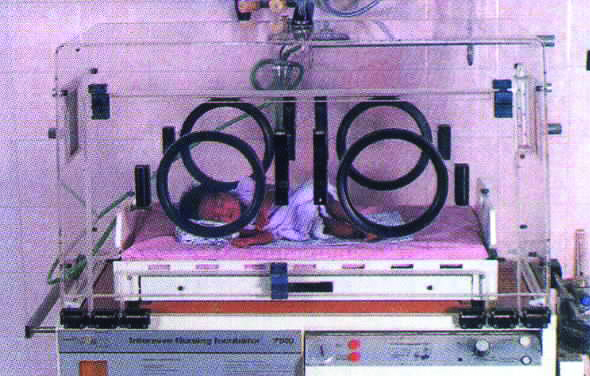
What makes Holy Spirit Hospital unique is its attitude to its patients. It is deeply committed to its motto, ‘Service in Love.’ We share the healing love of God with all without any distinction of caste, creed, religion or economic status. Right from its inception in 1967, the Sisters have worked tirelessly with one goal in mind: to bring quality health care within reach of the ordinary person.
It is highly commendable that in Mumbai, a city of 12 million and seen by many as the business capital of India, where quality healthcare is only available at a hefty price, our hospital offers state-of-the-art and up-to-date facilities at unbelievably subsidized rates. The hospital is ever grateful to its main donors from India and abroad for their generous contributions. They have played a vital role in enabling the hospital to maintain its commitment to the common tao.
Where we're called
Holy Spirit Hospital has come a long way. It gives quite a sense of satisfaction to look back on its achievements over the years. Looking ahead, we have many concerns. It is becoming increasingly difficult to provide quality health care at an affordable price. Since professional competence, using the latest medical technology, has become of prime importance, the challenge is to include the poor among its beneficiaries. Yet we are called to do this. Trusting in Divine Providence, we move forward with courage and determination, imploring God’s blessings in our efforts to help suffering humanity!
You may write to: Sr Mary Florence del Mundo SSpS, Convent of the Holy Spirit SOS P.O. Bannerghatta Road, Bangalore 560076, INDIA
Witnessing To The Flame Within
Four Columban lay missionaries now in their third year in Korea share their reflections as they began their mission there.
Cristina B. Simpron

They say ‘You don’t have to be rich in order to give. All you have to do is to be good; the person who is good can always find something to give.’ When I remember these words, which became the inspiration of my vocation, I also remember other lay people working in the church. I have seen their dedication, the simplicity of their lives and I admire them very much. They are catechists and parish workers whom I have been privileged to help. I can say I have a passion for working with young people. They have given me the capacity to learn many things about life and love. I believe in the capacity of young people to be agents of love, peace and transformation in society and the Church.
Then I realized that I too wanted to be a missionary. It was hard for me to leave my family, friends and community and join the Columban program. I am glad to share my experience of the Risen Lord with a new culture, new tradition, new friends and new family.
Arlenne B. Villahermosa
It all started with a dream. The attraction of mission work remained in my heart as a desire, and in my mind as a dream, for such a long time. I tried listening to it and responding in my own way. Apart from my job in the bank and my part-time teaching in the university, I made myself available with great joy to help in retreats, seminars and spiritual direction. I was happy with my life but I still felt called to something deeper. I finally decided to join the Columban Lay Missionary Program. I enjoyed the formation program with its different modules, courses and experiences. The detachment needed to leave my family has been difficult. But the mysterious and unconditional love I’ve received from God through my family, friends and the Columbans have encouraged me to share with others what I have so abundantly received
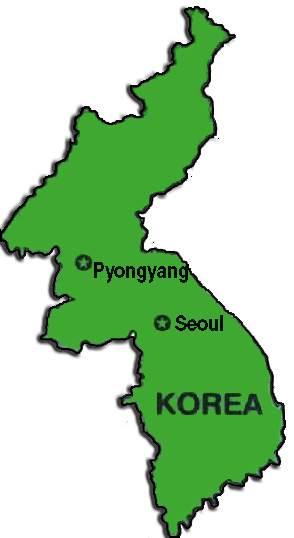
Tina M. Comacho
It was 1996 when I first met some Columban missionaries, a priest and a Sister. I was asked to help sell copies of Misyon in different parishes in Metro Manila. Because I myself had found the stories of missionaries in the magazine both fascinating and inspiring, it was easy for me to encourage others to read it also. Much later, after a long period of discernment, I realized that I also had a missionary vocation, and I was accepted for the Columban Lay Mission Program. I met various missionaries who shared their own experiences of mission. They fanned the flame that was already kindled within me and I knew from that time that one day I too would have my own story to tell.
I felt that the whole community was solidly behind me. With God within me, I know I am already a missionary story.
Necita A. Fetalvero
A call is a journey, a response to the innermost depths of longing for a presence and meaning within. It was from this mystery of longing that the biggest steps in my life began. I remember when I was first accepted to join the Columban Lay Mission Program. I struggled through the process of formation, but yet I found it an experience of growth towards the fullness of life. It was difficult for me to go beyond the limits of my boundaries and to offer myself for cross-cultural mission, yet I still chose to go. In spite of the joy and warmth, the love and security which I had always experienced as an only child, I still chose to be a missionary.
I realized that in being a missionary in Korea, the important thing is not so much what I do as who I am. It is the gift of myself that will give meaning to my vocation.
‘Unless The Church Becomes Young, It May Not Attract Youth’
An interview with Cora Mateo, Asia Youth Day pioneer
BANGALORE, India (UCAN) -- Young Catholics in Asia is not leaving the Church, but the Church is keeping distant from them, says the former executive secretary of the Federation of Asian Bishops' Conferences (FABC) Office of Laity.
Cora Mateo from the Philippines was very involved in the beginnings of Asian Youth Day (AYD), a biennial gathering of Catholic youth from Asian countries. UCA News interviewed her in Bangalore,India, 2,060 kilometers south of New Delhi, during the third AYD celebration, held Aug. 9-15. The first two were held in 1999 in Thailand and in 2001 in Taiwan.
Ms Mateo, now a consultant to the Youth Desk and in charge of AsIPA (Asian Integral Pastoral Approach) Desk that takes care of promoting the vision of a participatory Church, both desks being under the Office of Laity, spoke about her long experience working with young people and about her vision for young Asians and the Church.
She has been a lay missionary in Taiwan since 1964 and is a member of the lay Teresian Association (www.institucionteresiana.org) and currently serves on its general council in Rome.
The interview follows:
UCA NEWS: Are young people leaving the Church?
CORA MATEO: It is not the youth who are going away from the Church, but the Church is going away from the youth. The Church is slow to understand their tastes and ambitions, dreams and visions, and their ways and means. It has always maintained a safe distance from youth and never trusted them fully. In fact, the youth are trying to come closer to Church, but their closeness is suspiciously watched by the ‘fathers and mothers of the Church’ as too radical and difficult.
How could the Church attract young people?
Unless and until the Church becomes ‘young’ in mind and spirit, it may not attract the youth. I am sad to say that a large number of Church leaders do not have trust in young people. Forget about Church people not attracting the youth -- sadly, many prefer to keep them at a distance if they do not follow the prescribed ways. No wonder they become anti-social, anti-Church or anti-Christian.
We have not utilized the youth resources for good. We have not channeled their energy and enthusiasm for the kingdom of God. We have not involved them in our Church affairs and evangelization. In short, we have not accepted them as ‘very important persons in Church.’ That's why there is a distance.
What do you propose to attract young people?
To keep the youth with us, first of all we have to accept them as they are. We have to get into their shoes and understand them. They come to us with all their likes and dislikes. They may not prefer to sit for long sermons and rituals, but certainly they will listen to us if we speak their language. They may prefer the language of music, dance, drama, play and action.
The youth are basically searching for an identity and acceptance. They are looking for role models and examples to follow. If we are ready to give them what they want, we can hold them back and convert them as the greatest missionaries of modern times. The Church has to assign them new roles and responsibilities and make them enjoy the joy of Easter within the Church.
To my mind, the youth are the very core of the Church -- without them there is no Church.
What has been your personal experience with young people?
It is the youth who have changed me and given me a meaning in life. They have challenged me, but never let me down. They have questioned me, but never written me off for not answering them. I just walk with them and I think they like being with me. I am 61 years old, and some of them have come to say: ‘you inspire me.’
What motivated you to be involved in lay and youth ministry?
My attraction to the youth and my vocation to the lay apostolate are closely related. I belong to a secular lay association called Teresian Association, founded by Saint Pedro Poveda Castroverde, a great youth apostle. (Editor’s note: The Spanish priest and martyr, executed by Republican forces in 1936 at the beginning of the Spanish Civil War, was beatified by Pope John Paul II in 1993 and canonized on May 4, 2003.)
I became a member of this association in 1963 (at the age of 21) and took up youth ministry as my mission in the Church. The Teresian Association taught me to trust in youth and gave me the courage and strength to walk with them. I started my work with the youth through campus ministry, promoting Catholic students' associations.
How did the Asian Youth Day get started?
The youth themselves are the founders of AYD. We have just walked with them and assisted them with the necessary information and support. I happened to be the executive secretary of FABC Office of Laity, which the Youth Desk comes under, during the formation stages of AYD. So I was given charge in coordinating the efforts and motivating the youth in the realization of AYD. Much of the work was done by Mr Jun Hashimoto from Japan, who has been the Youth Desk Associate Secretary since 1995 when the initial planning started. This is his last AYD and from now on Ms Joy Candelario from Las Piñas, is the new Associate Secretary for the Youth Desk. She too has been very involved since 1997, with the other youth chaplains from India, Hong Kong, Malaysia, Thailand, the Philippines,Korea and other countries. We also received much support from the Salesians since the first one inThailand. This time, delegates for AYD III are from 19 Asian countries.
The idea for such a gathering came up during an FABC OL organized conference of youth (BILA – Bishops’ Institute for Lay Apostolate – on Youth) in Tagaytay in January 1997. And the seed was laid in August that year during the World Youth Day in Paris. (Pope John Paul II, who addressed the youth inParis, declared youth ministry as one of the most prioritized ministries in the Church). The Asian youth got an opportunity to be together one afternoon during WYD in Paris. It was the first AYG (Asian Youth Gathering) which led to the concretization of AYD.
Has youth ministry in Asia progressed since then?
The Church is slowly recognizing the youth presence. Most countries and dioceses now have a youth director and youth groups at parish, diocesan and national levels. The call by the Holy Father to integrate youth ministry with every apostolate made a significant impact on youth ministries in Asia. The youth are exposed to various realities during AYD and AYG and are made to develop an Asian vision of youth.
How do you evaluate the latest AYD gathering in India?
It was unique in many ways. First, there was better participation. The number of Pakistan delegates increased from two to 18. Sri Lanka and Bangladesh sent more than 20 delegates each. These nations had less than five delegates in past AYDs. Japan has also increased the number of their delegates from three to 18. Growing participation shows a positive trend.
India has organized the event in a unique way, which gave every participant a new experience. The organizers' arranging overseas participants to live with ‘a host family’ gave a new experience and exposure. The impact of that experience will last long.
Except for the long liturgical ceremonies in different Oriental rites, youth have enjoyed every bit of it. But even the liturgical services in Syro-Malabar and Syro-Malankara rites and the Indian Mass that incorporated cultural aspects of India were a new experience for the youth.
What is your vision for AYD?
If Asia is to decide the future of the Church, Asian youth must emerge as the heralds of the Good News. The youth have the potential to become effective peacemakers. More and more youth gatherings at local, regional, national and international levels can help the youth assert their identity as Catholic youth and be messengers of peace.
I see a good future for AYD as the Church has started realizing the potential of youth. The youth have also started getting more involved with Church life. If the Church learns to accept the youth, youth will feel co-responsible for the Church and make it more vibrant and energetic.
END
Salamat sa UCA News, www.ucanews.com
(Editor’s note: that is the form we have been asked to use.)
‘When You Learn, Teach; When You Get, Give’
By Nicholas Murray
Nicholas Murray went to Chinaafter serving for 12 years as Superior General of the Missionary Society of St Columban.
I’ve been teaching English in a university in Chongging in southwest China since September 2002. I chose to work in this part of China because it is somewhat less developed than the east and the government is now making efforts to develop the west. Chongging is at the center of that effort. I teach Oral English and a course in Western Culture for AB students majoring in English. The latter course in particular affords great scope for communicating values, with topics such as the Bible and Christianity, the Middle Ages, and the Renaissance and Reformation, to name but a few.
More than what I do
Not everybody sees the teaching of English in China as valid missionary work. Some believe I could be more profitably employed elsewhere. My own experience, limited though it still may be, convinces me that it is still eminently worthwhile and truly valid. It’s a new type of mission where all the familiar trappings which we have become accustomed to elsewhere have been stripped away and one is exposed to weakness and vulnerability. In such a situation one has to rely on the witness of one’s life and values, sustained by one’s personal prayer life and the private offering of the Eucharist, sometimes with a few foreign companions. It is fully in line with the Church’s teaching on mission, for the missionary task implies a respectful dialogue with those who do not yet accept the Gospel.
Personal approach
One gradually comes to work out one’s own modus operandi based on experience. I find it profitable to use my opening class to share about myself, my country, my family, my life, my work, my beliefs and values. I use this as a framework around which I build the oral exercises. They like this and it is amazing the amount they can remember about one and what one tells them. I make it very clear that I am a practicing Catholic, to enhance the witness value of my presence. I also lay particular emphasis on my having worked with university students in the Philippines in the area of leadership training.
My life as a message
The witness of presence can be particularly effective. As I have come to realize from personal experience. Some Chinese teachers of English, who employ journal writing as part of their course to the same students I teach, inform me that their students are deeply impressed by my life, work and values and have recorded such admiration in their journaling. One of those same students, actually the brightest in my own classes, one day shared the following reflection in my class. I was so deeply impressed that I asked her to write it out for me. Here is her sharing: ‘Never have I so seriously reflected on the power of religion (it is far from and alien to us Chinese). By sharing life’s journey with us, our Oral English teacher, Mr Nick, aroused my reflection on religion. Now I realize it’s not only a relief from anxiety, distress and grief, but also a motive for one who believes in it to strive to do good deeds; a way to have a noble heart and a remedy for spiritual barrenness. I feel that it is his beliefs that inspire Mr Nick to do what he has done. Now I’m thinking of converting to Christianity, though I’m quite at a loss about how to do it.’
Offering of self
My travels and lifestyle did not escape her attention and reflection either. She went on to say, ‘I could see Mr Nick’s eyes shining and face glowing when he referred to the places where he traveled: the Philippines, Brazil, Japan, Pakistan . . . to name just a few, and now China . . . When his privacy was intruded by a question about his own family he smiled and said, “No one will marry a man who never has enough time for his wife and children.” Now Mr Nick is 65-years-old and forty years have passed since he embarked on his road of serving and helping people. He sticks to the life-long pursuit, the calling, at the price of hardship, marriage and his precious youth (I know how difficult it is to travel around and help people). I was deeply moved when I heard Mr Nick’s answer to the question, “Is there one day when you will stop doing all these things?” “Yes,” he said, “when my health won’t allow it.” I was seized by this simple answer and began to realize how profound the saying is, “When you learn, teach; when you get, give.”’
Are you available for God?
I find enough inspiration in that simple, honest sharing to keep me going for another few years. It’s but one of the better among many others that help to make my ministry here in China inspiring and worthwhile. In this regard, I’m also encouraged by the advice of one of our co-founders, back in the 1920s, ‘You are not here to convert the people of China, you are here rather to make yourself available to God.’ I believe that helping young people to be more aware and responsible in today’s world is one response in that availability. Maybe you would like to join us for a stint.